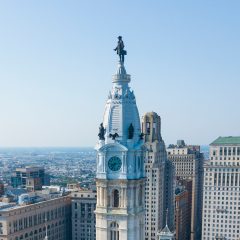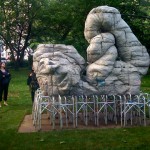Ed. note: This is my Weekly article about the McKinley School/Mural Arts Program project organized by (among others), Jennie Shanker. The piece ran Oct. 29, 2003 and I’m putting it here to get it in the artblog archives. I’m still looking for my photos and will put them in when I find them.
school’S OUT
Artist Jennie Shanker, drill in hand, is making final adjustments to the two new outdoor classrooms at the William Mckinley school. The classrooms look like pocket parks–charming and unexpected, nestled into niches on the sides of the school. They were completed under the city and school district’s five-year “Campus Park” initiative, which will create inviting outdoor spaces at select city schools.
These two were created in collaboration with the Mural Arts Program, City Play, Neighborhood Transformation Initiative, Pennsylvania Horticultural Society/ Philadelphia Green and the Philadelphia Eagles Youth Partnership. (Eagles team members also participated in a day of service at the school.)
The day before the classrooms get their formal dedication, artist shanker is attaching a small metal sculpture–a painted globe–to a bright green fence. The globe, one of many interactive sculptures in the math and science classroom, goes up easily, and shanker spins it on its axis. “You can draw on it with dry-erase marker,” she says proudly, explaining that everything in the garden-like space–from the big boulders to a pine tree to the globe–is for teaching.
Shanker worked with Anna Forrester of City Play to design the outdoor spaces, which include open areas for running around as well as quiet cozy nooks; places for group discussions and bright-colored teaching aids like the globe; several blackboard grids for word play; and a mechanism of the artist’s invention–an alphabet-odometer that can generate an infinite number of words.
The word generator, beautiful and elegant in its simplicity and clarity, is housed in a bright red box that looks like an old-fashioned bread box with a flip-up top. It’s also like a larger motorized version the artist created for her 1999-2000 Bird Park sculpture, Count Down.
It’s fitting that a project dedicated to education involves Shanker–an artist/educator–and students. Sixteen high school students, ages 14 to 18, from the Mural Arts Program’s Mural Corps, worked with Shanker and her assistants, Dan Costa and Jay Hardman. The teens also worked with mural painter Shira Walinsky, splitting their time between the metal shop at University of the Arts and the mural site. “They thought they’d be painting murals all summer,” Shanker says. “Little did they know they’d be doing metal work.”
For the outdoor classrooms, the students began by sketching flowers then translated the designs into welded steel sculptural elements. “I wasn’t sure it would work out,” Shanker says. “It was 90 degrees and you have to wear full [protective] gear, and a lot of the young women had salon nails and new sneakers. I told them they had to get some crappy clothes and they complained a little bit.”
By the end, regardless of the heat and the protective gear, the teens were with the program of MIG welding and plasma cutting steel. Some were even asking to stay late, and others were bringing family and friends by to show them what they’d done.
“They’re an inspiring group of kids,” Shanker says. “I created the structure; they did the rest.”
Shanker also found inspiration in the comments from the neighbors when they were installing. “We had a group of tough kids walk by us and we thought they’d give us some grief. They said, ‘Why didn’t you do that when we were there [at the school]?'”
Inside Mckinley, Principal Debora Carrera sits in a small office working the phone (a problem with a student) and the walkie-talkie (a class going off on a bus). The room’s doors are wide open, and Carrera, stylish in a black power suit, has about two seconds for me.
I ask her about the mural, and about the fact that she and some others affiliated with the school are depicted on the mural as their childhood selves. “It’s symbolic of having dreams and goals and achieving them,” Carrera says. What does she think of the outdoor classroom concept? “That’s my favorite,” she says. “It takes account of all types of learning. I was a kinetic learner–kinesthetic I think is the term–and I understand about other forms of learning.”
Three small children walk in and ask the principal about the kindergarten bake sale. Are there any cookies left? She doesn’t know, but she’ll find out. When I comment on her open-door policy, she laughs good-naturedly, “That’s the way it is.”
Before its facelift, Mckinley looked drab and embattled. Now, with its tropical colors, flower motifs and portraits of successful role models emblazoned on its exterior, the school broadcasts hopefulness and energy–crucial elements in education and neighborhood revitalization. It’s a perfect example of what art can offer a neighborhood.
>> See the outdoor classrooms and mural at the William Mckinley school, Orkney and Diamond sts.









